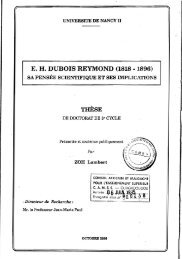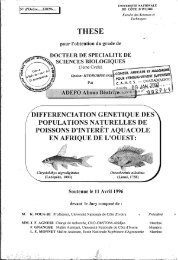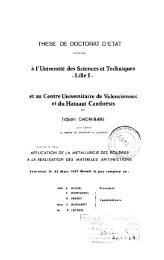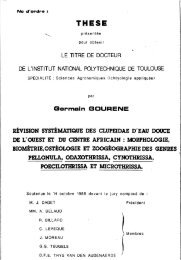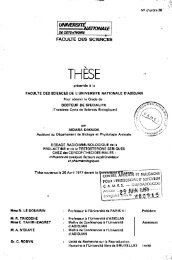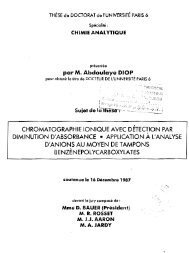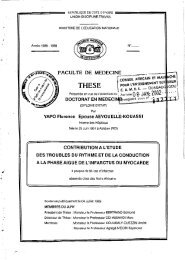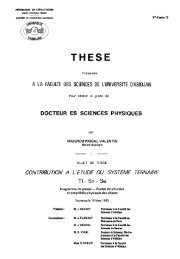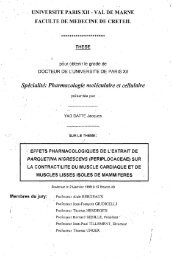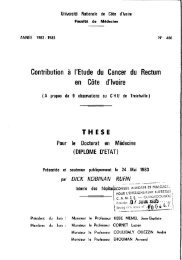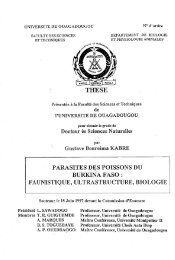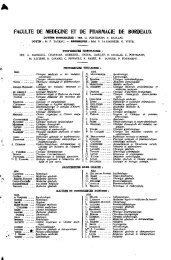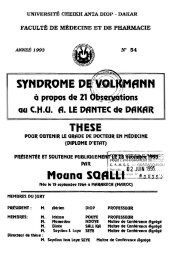In vitro antimicrobial activity of some medicinal plants from. Cameroon.
In vitro antimicrobial activity of some medicinal plants from. Cameroon.
In vitro antimicrobial activity of some medicinal plants from. Cameroon.
Create successful ePaper yourself
Turn your PDF publications into a flip-book with our unique Google optimized e-Paper software.
Pharm. Méd. Trad. Afr. 2004, Vo1.13,pp.161-173<br />
cornpounds in the methanol extract <strong>of</strong> <strong>medicinal</strong> <strong>plants</strong> studied. These kinds <strong>of</strong> differences in<br />
susceptibility arnong the rnicroorganisms against <strong>antimicrobial</strong> substances in <strong>plants</strong> extracts<br />
may be explained by the differences in cell wall composition For the bacteria, Gram-negative<br />
bacteria have an outer phospholipidic membrane arraying the structural lipopolysaccharide<br />
cornponents<br />
This makes the cell wall impermeable to lipophilic solutes. while porins<br />
constitute a selective barrier to the hydrophilic solutes with an exclusion limit <strong>of</strong>about 600 Da<br />
(Nikaido and Vaara, 1985). The Gram-positive bacteria should be more susceptible, having<br />
only outer peptidoglycan layer which is not an effective permeability barrier (Scherrer and<br />
Gerhardt,<br />
1971). The antifungal compounds <strong>of</strong> the <strong>plants</strong> assayed are not weil known;<br />
however, the presence <strong>of</strong> tlavonoidsand terpenes and certain degree <strong>of</strong> lipophicity might<br />
determine toxicity by the interactions with the membrane constituents and their arrangement<br />
(Tomas-Barberan et al., 1990)<br />
The results were encouraging and may suggest that methanol extract <strong>of</strong><strong>some</strong> <strong>medicinal</strong> <strong>plants</strong><br />
possess compounds with antibacterial and anticandidal properties which can be used as<br />
<strong>antimicrobial</strong> agents in new drugs for therapy <strong>of</strong>infectious diseases.<br />
Acknowledgements<br />
This research was financially supported by the <strong>In</strong>ternational Foundation for Sciences (IFS).<br />
Stockholn, Sweden, and the Organisation for the prohibition <strong>of</strong>chemical Weapons, the Hague,<br />
The Netherlands, through a Grant to Dr D.E. Pegnyemb N°F/330- 1. We would like to thank<br />
Dr M. Satabie, M. Nana and M Koufani (National Herbarium) M N. Tsabang<br />
(CRPMT/lMPM), Dr Zapfack (department <strong>of</strong> Botanic UYl) for collection and Identification<br />
<strong>of</strong> <strong>plants</strong> materials We thank also Drs A. Ngandjio (Centre Pasteur du Cameroun) and H.<br />
Gonsu (Centre Hospitalier et Universitaire) for generously contributing to the strain collection.<br />
167



